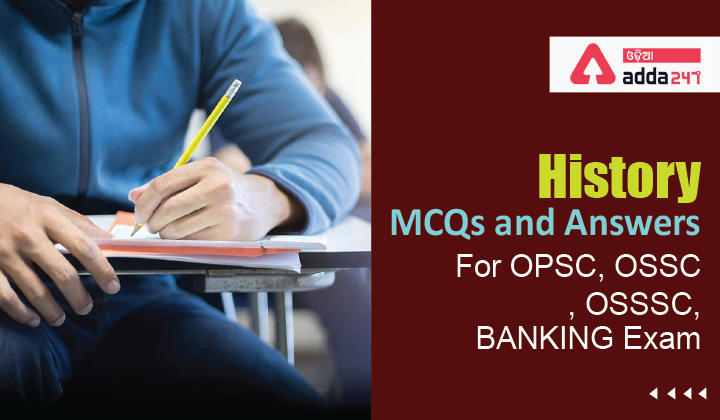History MCQs and Answers: History MCQs are very important for OPSC, OSSC, OSSSC & Other State Exams. Aspirants who are willing to apply for the various Government exams 2022 must go through the topics of History for competitive exams, as History is a key part of the syllabus.
Download ADDA247 Odia APP – Appear Latest Exam Test Series & Live Classes
Q1. Who built Jama Masjid?
(a) Guru Ramdas
(b) Shah Jahan
(c) Rao Jodhaji
(d) Mahatma Gandhi
S1. Ans.(b)
Sol. Mughal Emperor Shah Jahan built the Jama Masjid between 1644 and 1656. It was constructed by more than 5000 workers. It was originally called Masjid-i-Jahan Numa, meaning ‘mosque commanding view of the world’.
Q2. Which of the following was a leader of the Hindustan Socialist Republican Army founded in 1928?
(a) Khudiram Bose
(b) Asfaqullah Khan
(c) Chandra Shekhar Azad
(d) Subhash Chandra Bose
S2. Ans.(c)
Sol. Hindustan Socialist Republican Association (HSRA) was a revolutionary organisation, also known as Hindustan Socialist Republican Army established in 1928 at Feroz Shah Kotla in New Delhi by Chandrasekhar Azad, Bhagat Singh, Sukhdev Thapar and others.
Q3. Who was the founder of Banaras Hindu University?
(a) Sukumar Dutt
(b) Madan Mohan Malvia
(c) Dr. Rajendra Prasad
(d) Motilal Nehru
S3. Ans.(b)
Sol. Banaras Hindu University formerly Central Hindu College, is a public central university located in Varanasi, Uttar Pradesh. Established in 1916 by Pandit Madan Mohan Malaviya. With over 12,000 students residing in campus, it claims the title of largest residential university in Asia.
Q4. Who founded the Pala Empire?
(a) Devapala
(b) Dharmapala
(c) Dhruva
(d) Gopala
S4. Ans.(d)
Sol. Dharmapala (ruled 8th century) was the second ruler of the Pala Empire of Bengal region in the Indian Subcontinent. He was the son and successor of Gopala, the founder of the Pala Dynasty. He greatly expanded the boundaries of the empire, and made the Palas a dominant power in the northern and eastern India.
Q5. Who wrote Akbarnama?
(a) Akbar
(b) Birbal
(c) Abul Fazal
(d) Bhagavan Das
S5. Ans.(c)
Sol. Abul Fazl was the author of Akbarnama, the official history of Akbar’s reign in 3 volumes. This book gives the history of Akbar’s forefathers from Timur to Humayun and Akbar’s reign till 1602 AD. Abul Fazl was one of the nine jewels in the royal court of Akbar.
Q6. The word Swaraj was first used by Dadabhai Naoroji in the congress session held in ________ at ________.
(a) 1904, Bombay
(b) 1906, Calcutta
(c) 1907, Surat
(d) 1916, Lucknow
S6. Ans.(b)
Sol. The Correct answer is 1906, Calcutta.
The word swaraj was first used by Dadabhai Naoroji in the congress session held at Calcutta in 1906.
Q7. Sarojini Naidu was the President of which Congress session
(a) 1922, Gaya
(b) 1928, Calcutta
(c) 1925, Kanpur
(d) 1931, Karachi
S7. Ans.(c)
Sol. Sarojini Naidu:
She became the president of the Indian National Congress in the Kanpur session in 1925.
She was given the title of “Nightingale of India” for her contributions in the field of poetry writing.
Q8. Which session of INC passed the famous 4 resolutions, namely – swaraj, swadeshi, Boycott and National Educations?
(a) 1906 Calcutta session
(b) 1920 Calcutta session
(c) 1929 Lahore session
(d) 1919 Amritsar session
S8. Ans.(a)
Sol. 1906 Calcutta session:
This session was held under the presidentship of Dadabhai Naoroji.
This session of INC passed the famous 4 resolutions, namely – swaraj, swadeshi, Boycott, and National Educations.

Q9. Who among the following witnessed the reigns of eight Delhi Sultans?
(a) Ziauddin Barani
(b) Shams-i-siraj Afif
(c) Minhaj-us-siraj
(d) Amir Khusrau
S9. Ans.(d)
Sol. Amir Khusrau (1253-1325) is regarded as the “father of qawwali” .He was an Indian musician, scholar and poet. He was an iconic figure in the cultural history of the Indian subcontinent.He is said to have witnessed the reigns of eight Delhi Sultans from ‘Ghiyasuddin Balban to Sultan Muhammad bin Tughluq’.
Q10. From where the Mansabdari system was borrowed?
(a) Afghanistan
(b) Turkey
(c) Mongolia
(d) Persia
S10. Ans.(c)
Sol. Mansabdar implies the generic term for the military-kind grading of all royal functionaries of the Mughal Empire. The Mansabdari system introduced by Akbar was borrowed from the system followed in Mongolia.
Q11. When did Vasco da Gama discover the Indian sea route?
(a) 1460
(b) 1498
(c) 1519
(d) 1524
S11. Ans.(b)
Sol. India was a source of spices that were scarce and costly to Europe. Vasco Da Gama’s discovery of the Indian Sea route lead to more trade opportunities in India. He discovered the india in 1498.
Q12. Who was the first Governor-General of India?
(a) Edmund Burke
(b) Lord William Bentinck
(c) Robert Clive
(d) Warren Hastings
S12. Ans.(d)
Sol. Warren Hastings became the Governor-General of India in 1773.
Q13. When did Hyder Ali attack the British?
(a) 1773
(b) 1775
(c) 1780
(d) 1782
S13. Ans.(c)
Sol. Hyder Ali attack the British in 1780.
Hyder Ali Khan was the sultan of the Kingdom of Mysore in southern India.
Q14. NawabSiraj-ud-Daulah of Bengal was defeated by the English in the battle of Plassey, mainly?
(a) because the English forces were much stronger than those of the Nawab
(b) because of Clive’s conspiracy with the Nawab’s Commander-in-Chief Mir Jafar and rich bankers of Bengal
(c) because of Siraj-ud-Daulah’s retirement from the battlefield
(d)because of the capture of a band of Frenchmen under the Nawab’s service by the English
S14. Ans.(b)
Sol. NawabSiraj-ud-Daulah of Bengal was defeated by the English in the battle of Plassey, mainly because of Clive’s conspiracy with the Nawab’s Commander-in-Chief Mir Jafar and rich bankers of Bengal
Q15. When did Maharaja Ranjit Singh die?
(a) 1839
(b) 1845
(c) 1848
(d) 1856
S15. Ans.(a)
Sol. Maharaja Ranjit Singh was the founder of the Sikh Empire.
History MCQs and Answers For Odisha Exam
Reasoning MCQs and Answers For Odisha Exam














